Chili peppers nutrition facts
Chili peppers, despite their fiery hotness, are one of very popular spices known for their medicinal and health benefiting properties. The chili, actually, is a fruit pod from the plant belonging to the nightshade family (Solanaceae), within the genus, capsicum.
Scientific name: Capsicum annum. Some of other common members in the Solanaceae family are tomato, aubergine,potato, etc.
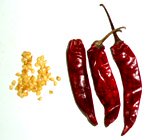 |
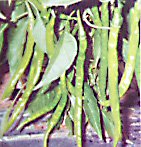 |
| Dry chilli peppers with seeds. | Raw green chilies in acapsicum annum plant. |
Chili plant is a small, perennial shrub with woody stem, growing up to a meter in height. It is native to Central American region where it employed as one the chief spice ingredients in Mexican cuisine for centuries. Later, it was introduced to the rest of the world by Spanish and Portuguese explorers during the 16th and 17th centuries. Today chili pepper is grown widely in many parts of the world as an important commercial crop.
Several cultivars of chili peppers grown all around the world. Depending upon cultivar type, it bears flowers which subsequently develop into fruit pods of variable size, shape, color, and pungency. And again, depending on the cultivar type, their hotness ranges from mild, fleshy (Mexican bell peppers) to fiery, tiny, Nag Jalokiya chili peppers of Indian subcontinent. The hotness of chili is measured in “Scoville heat units” (SHU). On the Scoville scale, a sweet bell pepper scores 0, a jalapeño pepper around 2,500-4,000 units, and a Mexican habañeros may have 200,000 to 500,000 units.
Inside, each chili fruit pod features numerous tiny, white, or cream colored, circular, flat seeds which clinging on to the central white-placenta.
To harvest, chilies can be picked up while they are green, or when they reach complete maturity and dry on the plant itself. In general, the fruits are ready for harvesting once they mature and turn red. They are then left to dry under sunlight and srink in size.
Chilies have a strong spicy taste that comes to them from the active alkaloid compounds: capsaicin, capsanthin andcapsorubin.
Health benefits of chili peppers
- Chili pepper contains an impressive list of plant derived chemical compounds that are known to have disease preventing and health promoting properties.
- Chilies contain health benefiting an alkaloid compound in them, capsaicin, which gives them strong spicy pungent character. Early laboratory studies on experimental mammals suggest that capsaicin has anti-bacterial, anti-carcinogenic, analgesic and anti-diabetic properties. It also found to reduce LDL cholesterol levels in obese individuals.
- Fresh chili peppers, red and green, are rich source of vitamin-C. 100 g fresh chilies provide about 143.7 µg or about 240% of RDA. Vitamin C is a potent water-soluble antioxidant. It is required for the collagen synthesis inside the human body. Collagen is one of the main structural protein required for maintaining the integrity of blood vessels, skin, organs, and bones. Regular consumption of foods rich in vitamin C helps protect from scurvy, develop resistance against infectious agents (boosts immunity), and scavenge harmful, pro-inflammatory free radicals from the body.
- They are also good in other antioxidants such as vitamin-A, and flavonoids like ß-carotene, a-carotene, lutein, zea-xanthin, and cryptoxanthin. These antioxidant substances in capsicum help protect the body from injurious effects of free radicals generated during stress, diseases conditions.
- Chilies carry a good amount of minerals like potassium, manganese, iron, and magnesium. Potassium is an important component of cell and body fluids that helps controlling heart rate and blood pressure. Manganese is used by the body as a co-factor for the antioxidant enzyme, superoxide dismutase.
- Chilies are also good in B-complex group of vitamins such as niacin, pyridoxine (vitamin B-6), riboflavin and thiamin (vitamin B-1). These vitamins are essential in the sense that human body requires them from external sources to replenish.
Chili peppers have amazingly high levels of vitamins and minerals. Just 100 g provides (in % of recommended daily allowance):
240% of vitamin-C (Ascorbic acid),
39% of vitamin B-6 (Pyridoxine),
32% of vitamin A,
13% of iron,
14% of copper,
7% of potassium,
but no cholesterol.
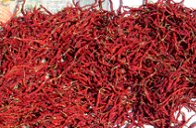 |
| Sun-dried red chili peppers. |
Chili peppers can be available year around in the markets either in the fresh, dried or powdered form. In the stores, buy fresh chili peppers instead of powder since, oftentimes it may contain adulterated spicy mixtures.
Look for raw, fresh chilies featuring brilliant color (green, yellow, orange, red depending on the variety), with healthy stalk, wholesome and compact. Avoid those with spots or those spoiled tips and inflicted by molds.
Once at home, they should be stored in the refrigerator inside a plastic bag where they will stay fresh for about a week. Completely dried red chilies are also available in the markets. Dry chilies can be stored at room temperature in a cool, dark place, inside airtight containers for many months; and can be milled to powder using mixer/grinder as and when required. If you want to buy dry chili powder instead, go for authentic and branded products. Powdered chili pepper should be stored in cool place inside an airtight container.
Medicinal uses
- Chili peppers contain chemical compound, capsaicin. Capsaicin and its co-compounds being employed in the preparation of ointments, rubs and tinctures for their astringent, counter-irritant and analgesic properties.
- These formulations have been in use in the treatment of arthritic pain, post-herpetic neuropathic pain, sore muscles, etc.
- Scientific studies on experimental mammals suggest that capsaicin has anti-bacterial, anti-carcinogenic, analgesic and anti-diabetic properties. It also found to reduce LDL cholesterol levels in obese persons.
Culinary uses
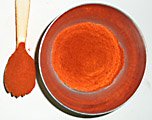 |
| Red chili pwder. |
Raw, fresh chilies should be washed in clean water before used in cooking in order to remove any residual fungicides, and sand. Chilies, either fresh or ground, can cause severe burning sensation to hands and severe irritation to nasal passages, eyes and throat. Therefore, it may be advised in some sensitive individuals to use thin hand gloves and face masks while handling chilies.
Here are some serving tips:
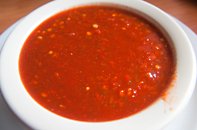 |
| Red chili sauce. |
- Fresh raw bell peppers and other sweet, mild variety peppers are being used as vegetables in cuisines in many parts of the world.
- Chopped peppers are being used in the preparation of chili sauce, pizzas, rolls, and in variety of dishes using fish, meat and chicken in many Central American and European regions.
- Dried chili powder is an important ingredient in the spice mix known as curry powder in many Asian countries.
- Hot chilies used as a condiment in the preparation of soups, chili sauce, spicy water, vinegar-spice mix, etc.
- Chilies, soaked in yogurt and then dried under sunlight, are used as condiment side-dish which served during dinner time in south-Indian states.
Safety profile
Chili peppers contain capsaicin, which gives strong spicy pungent character. Capsaicin when eaten causes severe irritation and hot sensation to mouth, tongue and throat.
- Capsaicin in chilies initially elicits local inflammation when it comes in contact with mucusa of oral cavity, throat and stomach, and soon causes severe burning sensation that is perceived as ‘hot’ through free nerve endings in the mucosa. Eating cold yogurt helps reduce the burning pain by diluting capsaicin concentration and preventing its contact with mucosal walls.
- Avoid touching eyes with chili-contaminated fingers. Rinse eyes thoroughly in cold water to reduce irritation.
- Chilies may aggravate existing gastro-esophageal reflux (GER) condition.
- Certain chemical compounds like aflatoxin (fungal mold), found in spoiled chilies have been known to cause stomach, liver and colon cancers. (Medical-disclaimer).




Facebook Comments